
Calgary Transit is the public transit agency which is owned and operated by the city of Calgary, Alberta, Canada. In 2019, an estimated 106.5 million passengers boarded approximately 1,155 Calgary Transit vehicles. It operates light metro (LRT), urban tramway, bus rapid transit (BRT), para-transit, and regular bus services. In 2022, the system had a ridership of 103,306,500, or about 389,000 per weekday as of the fourth quarter of 2022.
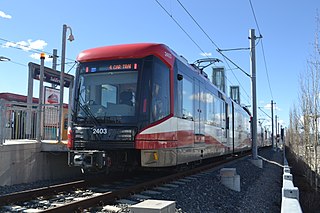
CTrain is a light rail rapid transit system in Calgary, Alberta, Canada. Much of the system functions as a high-capacity light metro, while in the downtown free-fare zone trains transitions into a tram with a dedicated right-of-way. The CTrain began operation on May 25, 1981 and has expanded as the city has increased in population. The system is operated by Calgary Transit, as part of the Calgary municipal government's transportation department. In 2022, the system had a ridership of 61,889,500, or about 228,800 per weekday as of the fourth quarter of 2022, making it one of the busiest light rail transit systems in North America. Approximately 45% of workers in Downtown Calgary take the CTrain to work.

Chinook station is a CTrain light rail station in Manchester, Calgary, Alberta. The station opened on May 25, 1981, as part of the original South line on the Red Line.

Banff Trail station is a CTrain light rail station in Banff Trail, Calgary, Alberta, Canada. It serves the Northwest Line and opened on September 7, 1987, as part of the original line. It is located on the exclusive LRT right of way on the east side of Banff Trail NW, 4.1 km northwest of the 7 Avenue & 9 Street SW interlocking. The station consists of two side-loading platforms with grade-level access from a pedestrian crossing of the tracks at the northern end of the station.

Brentwood Station is a Calgary C-Train light rail station on the Red Line, between University Station southbound and Dalhousie Station northbound. The station is located in the middle of Crowchild Trail, wedged between the communities of Brentwood to the north, and Varsity to the south. The station acts as a transfer point, connecting with the bus routes of MAX Orange, North Pointe, Foothills Medical Centre, Dalhousie, Chinook, Greenwood/Brentwood, Market Mall, Downtown West, Nolan Hill, and Valley Ridge.
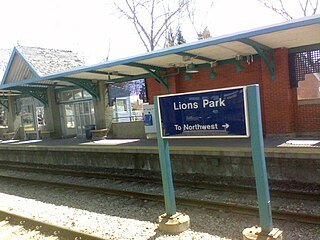
Lions Park station is a Calgary C-Train light rail station in Hounsfield Heights-Briar Hill, Calgary, Alberta, Canada. Opened on September 7, 1987 as part of the original Northwest Line. It is located on the exclusive LRT right of way on the south side of 14 Avenue NW, just east of 19 Street NW. Two side-loading platforms with ramp access from grade level as well as pedestrian crossings are located at both ends of the station. The station is located adjacent to the Mall Entrance 5 of the North Hill Centre shopping mall, and is less than 1 kilometre away from the campus of SAIT.
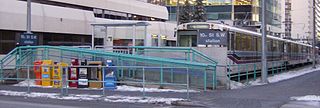
10 Street Southwest station was a CTrain light rail station in Calgary, Alberta, Canada. It was the western terminus of Route 202. It was closed and replaced with Downtown West–Kerby station.

Victoria Park/Stampede station is CTrain light rail station in Beltline, Calgary, Alberta, Canada. Adjacent to the Stampede Park, the site of the Calgary Stampede, opened on May 25, 1981, as part of the original line.

39 Avenue Station is a Calgary C-Train LRT station on the south leg of the Red Line, between Erlton-Stampede Station southbound and Chinook Station northbound. The station is located inside of the community of Manchester, an industrial community in Calgary, Alberta. 39 Avenue Station opened on May 25, 1981, as part of the original South line. The station is located on the exclusive LRT right of way 3.4 kilometres south of the City Hall Interlocking, at 39 Avenue SE, just east of Macleod Trail.

Shawnessy is a CTrain light rail station in Shawnessy, Calgary, Alberta. It serves the South Red Line. It is located on the exclusive LRT right of way, 16 km south of the City Hall interlocking.

Somerset–Bridlewood station is a CTrain light rail station in Somerset, Calgary, Alberta, Canada. It is the current southern terminus of the South Line. The station is one of two that opened on June 28, 2004 as part of the South LRT Extension Phase II. The station is located on the exclusive LRT right of way, 16.9 km south of the City Hall interlocking along Shawville Gate. 913 parking spaces are included in the park-and-ride facility at the station.
Crowchild Trail is a major expressway in western Calgary, Alberta. The segment from the 12 Mile Coulee Road at the edge of the city to 16 Avenue NW is designated as Highway 1A by Alberta Transportation. The road is a critical north-south link in West Calgary for both downtown bound traffic and travel between the two quadrants of the city it passes through. Although planned to be one single freeway from Glenmore Trail to the city limits, the route is currently divided by a section of slow moving arterial road with four signalized intersections between 24 Avenue and Memorial Drive. This causes the freeway in the northwest to separated from the freeway south of the Bow River. Filling the gap and making the whole route a minimum six lane freeway is currently planned for construction beyond 2027.
The city of Calgary, Alberta, has a large transportation network that encompasses a variety of road, rail, air, public transit, and pedestrian infrastructure. Calgary is also a major Canadian transportation centre and a central cargo hub for freight in and out of north-western North America. The city sits at the junction between the "Canamex" highway system and the Trans-Canada Highway.

Light rail is a commonly used mode of public transit in North America. The term light rail was coined in 1972 by the Urban Mass Transportation Administration to describe new streetcar transformations which were taking place in Europe and the United States. The Germans used the term Stadtbahn, which is the predecessor to North American light rail, to describe the concept, and many in UMTA wanted to adopt the direct translation, which is city rail. However, in its reports, UMTA finally adopted the term light rail instead.
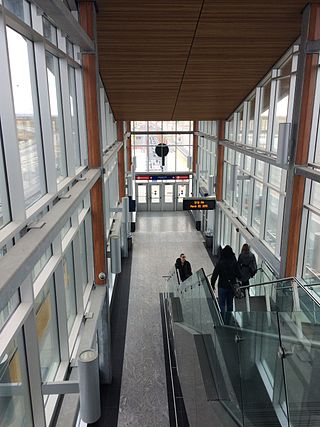
Tuscany station is a CTrain light rail station in Tuscany and Rocky Ridge, Calgary, Alberta, Canada. It is the northern terminus of the Northwest Line, and opened as part of the route's the 2 km extension on August 23, 2014. Originally referred to in planning documents as Tuscany/Rocky Ridge station, Calgary Transit simplified the name on the recommendation of the Community Consultation Committee.

Saddletowne station is a CTrain light rail station in on the Northeast Line in Saddle Ridge Calgary, Alberta. Opened on August 27, 2012 as part of a 2.9-km extension.

The Blue Line, also known as Route 202, is a light rail transit (LRT) line in Calgary, Alberta, Canada. Partnered with the Red Line, and future Green Line it makes up Calgary's CTrain network. Following its initial approval in 1976, the Red Line opened in 1981, with the first trains running on what is now the Blue Line in 1985.
The Green Line is a light rail (LRT) line under construction in Calgary, Alberta, Canada. The line will run between Calgary’s north-central and southeastern boundaries, connecting with the Red Line and Blue Line in the city’s downtown. The Green Line is the largest public infrastructure project in Calgary's history and will be the first rail line in the city to operate low-floor trains. When completed, the Green Line will comprise 29 stations spanning 46 kilometres (29 mi). This will bring the total number of CTrain stations in Calgary to 74.
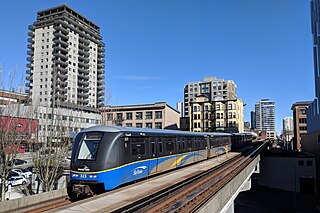
Urban rail transit in Canada encompasses a broad range of rail mass transit systems, including commuter rail, rapid transit, light rail, and streetcar systems.















